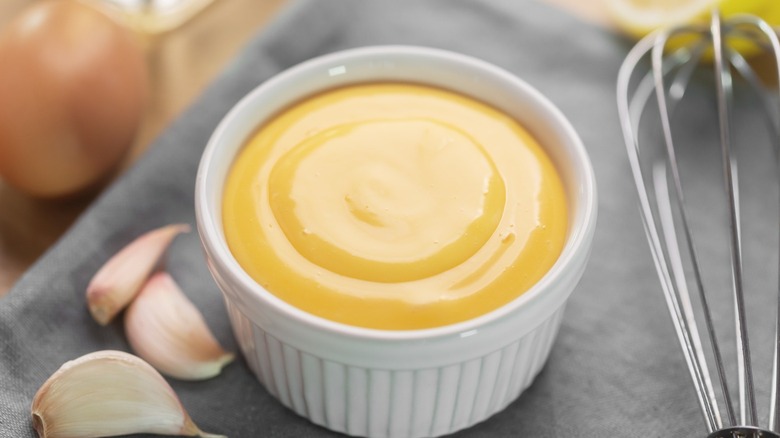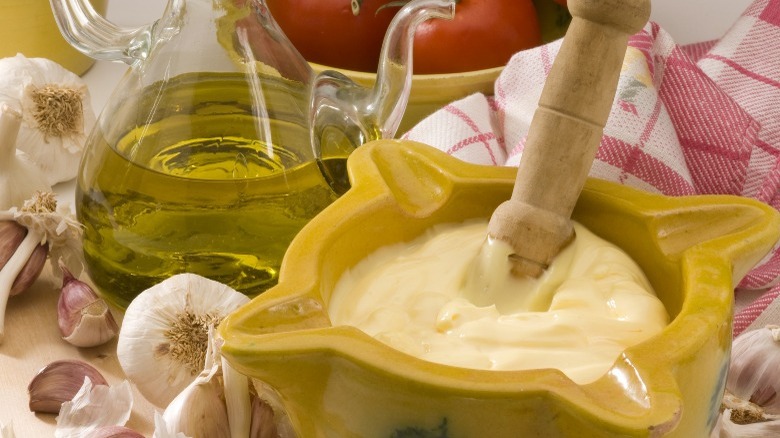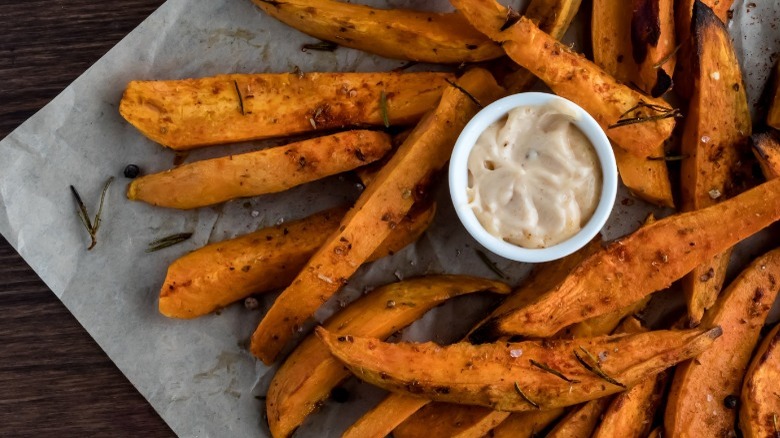Why It Pays To Make Aioli At Home
Aioli — that creamy, garlicky, silky wonder that seems to brighten the flavor of everything it lands on. It tastes great on veggies like artichokes, asparagus, and most especially French fries. A little dollop on top of broiled fish, jammy soft-boiled eggs, or stirred into a bowl of seafood soup can be a revelation. A generous spread of aioli's many tantalizing herbaceous or spicy variations on just about any kind of sandwich, from breakfast to lunch, including Chef Alvin Cailan's 'Damn Fancy' burger, can take it to the next level. More simply put, a good aioli can really make a dish sing.
But why wait until your next visit to your favorite restaurant for this fat-luscious flavor enhancer? You don't have to! In fact, you might be surprised to learn that although aioli sounds and tastes a bit luxurious, it's really pretty simple to whip up right in your own kitchen, where you can decide exactly how fancy, classic, or edgy you'd like to get with the whole operation.
What exactly is aioli?
According to Bon Appétit, true aioli, in the traditional Mediterranean preparation, is the fluffy, creamy result of emulsifying flavorful olive oil, with crushed garlic, using a mortar and pestle. Today's basic aioli recipes have a few more ingredients, commonly made with a mix of olive oil, eggs, garlic, salt, and lemon. Which, may sound a lot like your favorite mayonnaise recipe — plus garlic. And truthfully, it's not that far off. This is why some folks, like cookbook author and Cookie and Kate food blogger Kathryn Taylor chose to shortcut the process in her easy-to-make "Cheater's Aioli," recipe, starting with jarred mayo and adding the requisite garlic flavor in an infusion.
But aioli's potential flavor infusions don't stop at garlic; you'll find aiolis made with roasted sweet red bell peppers, herbs like basil, rosemary, and saffron, spices like paprika, and fiery chilies from chipotle to sriracha and gochujang. Even bacon gets a top spot in this mouthwatering line-up, as bacon aficionado and cookbook author, Eliza Cross (who founded BENSA Bacon Lovers Society) puts it, "It's like the creamiest, silkiest homemade mayonnaise with hints of smoky bacon, garlic, and lemon."
It's a matter of taste
So why should you make aioli at home? For the same reason you'd make mayonnaise at home — the taste. MasterClass notes, "Homemade mayonnaise tastes fresher than the grocery-store stuff, which contains binding agents to make it shelf stable." The same is true for Mayo's cooler cousin, aioli. While you can whip up a quick, tasty (and more shelf-stable) aioli at home starting with mayonnaise from a jar, if you have just a little bit more time, it really pays off to start from scratch with your aioli. Martha Stewart asserts that homemade aioli is "Miles ahead of the jarred stuff in terms of flavor and texture."
And making your own aioli allows you creative freedom — no longer hemmed in by the slim choice of aioli flavors offered at local restaurants or stocked on your grocer's shelves. Untethered and free to play with your favorite herbs, spices, and chiles, you can explore combinations you've never tasted before, the way Norwood Lavender Farm did with their Lavender Chicken Waffle Sandwich with Lemon Lavender Aioli or in Chef Jose Garces' smoky paprika aioli.
Just be sure to use it all up as soon as you can, as Very Well Fit cautions; the raw eggs in today's modern aioli recipes mean you'll need to use your aioli within four days to ensure it's fresh and safe. With that in mind, you'll find that just like homemade mayo, from-scratch aioli is not to be missed — its light, fluffy, and creamy texture is heavenly and the flavor possibilities are endless.


